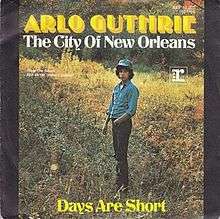City of New Orleans (song)
"City of New Orleans" is a country folk song written by Steve Goodman (and first recorded for Goodman's self-titled 1971 album), describing a train ride from Chicago to New Orleans on the Illinois Central Railroad's City of New Orleans in bittersweet and nostalgic terms.
| "City of New Orleans" | |
|---|---|
| Single by Steve Goodman | |
| from the album Steve Goodman | |
| B-side | "Would You Like to Learn to Dance?" |
| Released | 1971 |
| Recorded | 1971 |
| Genre | Folk, Country |
| Length | 3:52 |
| Label | Buddah |
| Songwriter(s) | Steve Goodman |
| Producer(s) | Kris Kristofferson, Norbert Putnam |
Goodman got the idea while traveling on the Illinois Central line for a visit to his wife's family. The song has been recorded by numerous artists both in the US and Europe, including two major hit versions: first by Arlo Guthrie in 1972, and later by Willie Nelson in 1984.
An article in the September 2017 issue of Trains magazine chronicles the writing and recording of the song and includes a biographical sketch of Steve Goodman.[1]
Arlo Guthrie version
| "The City of New Orleans" | |
|---|---|
 | |
| Single by Arlo Guthrie | |
| from the album Hobo's Lullaby | |
| B-side | "Days Are Short" |
| Released | July 1972 |
| Recorded | 1972 |
| Genre | Folk |
| Length | 4:31 |
| Label | Reprise |
| Songwriter(s) | Steve Goodman |
| Producer(s) | Lenny Waronker, John Pilla |
While at the Quiet Knight bar in Chicago, Goodman saw Arlo Guthrie, and asked to be allowed to play a song for him. Guthrie grudgingly agreed, on the condition that if Goodman bought him a beer, Guthrie would listen to him play for as long as it took to drink the beer.[2] Goodman played "City of New Orleans", which Guthrie liked enough that he asked to record it. The song was a hit for Guthrie on his 1972 album Hobo's Lullaby, reaching #4 on the Billboard Easy Listening chart and #18 on the Hot 100 chart; it would prove to be Guthrie's only top-40 hit and one of only two he would have on the Hot 100 (the other was a severely shortened and rearranged version of his magnum opus "Alice's Restaurant", which hit #97).
Willie Nelson version
| "City of New Orleans" | ||||
|---|---|---|---|---|
| Single by Willie Nelson | ||||
| from the album City of New Orleans | ||||
| B-side | "Why Are You Pickin' on Me" | |||
| Released | July 1984 | |||
| Recorded | October 1983 | |||
| Genre | Country | |||
| Length | 4:47 | |||
| Label | Columbia | |||
| Songwriter(s) | Steve Goodman | |||
| Producer(s) | Chips Moman | |||
| Willie Nelson singles chronology | ||||
| ||||
Steve Goodman won a posthumous Grammy Award for Best Country Song at the 27th Grammy Awards in 1985 for Willie Nelson's version, which was included on Nelson's 1984 album City of New Orleans. It reached #1 on both the Billboard Hot Country Singles chart in the United States[8] and the RPM Country Tracks chart in Canada.
Chart performance
| Chart (1984) | Peak position |
|---|---|
| US Hot Country Songs (Billboard)[9] | 1 |
| US Adult Contemporary (Billboard)[10] | 30 |
| Canadian RPM Country Tracks | 1 |
| Canadian RPM Adult Contemporary Tracks | 3 |
Notable cover versions
Joe Dassin recorded a French cover, titled "Salut les amoureux" ("Hello, lovers").[11]
References
- Sanders, Craig. "Writing of 'City of New Orleans'". Trains 77(9):34-39.
- Central, Spotlight (15 November 2016). ""Running Down the Road" Arlo Guthrie LIVE! at The Grunin Center". Medium. Retrieved 1 February 2018.
- "Image : RPM Weekly - Library and Archives Canada". Bac-lac.gc.ca. Retrieved 2016-11-17.
- "Image : RPM Weekly - Library and Archives Canada". Bac-lac.gc.ca. Retrieved 2016-11-17.
- "Arlo Guthrie Chart History (Hot 100)". Billboard.
- Whitburn, Joel (2002). Top Adult Contemporary: 1961-2001. Record Research. p. 109.
- "Top 100 Hits of 1972/Top 100 Songs of 1972". Musicoutfitters.com. Archived from the original on 2017-04-27. Retrieved 2016-11-17.
- Whitburn, Joel (2004). The Billboard Book Of Top 40 Country Hits: 1944-2006, Second edition. Record Research. p. 245.
- "Willie Nelson Chart History (Hot Country Songs)". Billboard.
- "Willie Nelson Chart History (Adult Contemporary)". Billboard.
- "Track of the Day: 'Salut Les Amoureux' by Joe Dassin". The Atlantic. 2016-10-22. Retrieved 2017-11-30.
External links
- Original lyrics at the Wayback Machine (archived October 20, 2006)
- Arlo Guthrie cover lyric version at the Wayback Machine (archived November 21, 2006)
- Classic Tracks: Arlo Guthrie's "City of New Orleans"